Indian Ocean Trade Routes
Indian Ocean Trade Routes
:max_bytes(150000):strip_icc()/IndianOceanTrade-56a042475f9b58eba4af9165.jpg)
Dr. Kallie Szczepanski is a history teacher specializing in Asian history and culture. She has taught at the high school and university levels in the U.S. and South Korea.
The Indian Ocean trade routes connected Southeast Asia, India, Arabia, and East Africa, beginning at least as early as the third century BCE. This vast international web of routes linked all of those areas as well as East Asia (particularly China).
Long before Europeans “discovered” the Indian Ocean, traders from Arabia, Gujarat, and other coastal areas used triangle-sailed dhows to harness the seasonal monsoon winds. Domestication of the camel helped bring coastal trade goods such as silk, porcelain, spices, incense, and ivory to inland empires, as well. Enslaved people were also traded.
Classic Period Indian Ocean Trading
During the classical era (4th century BCE–3rd century CE), major empires involved in the Indian Ocean trade included the Achaemenid Empire in Persia (550–330 BCE), the Mauryan Empire in India (324–185 BCE), the Han Dynasty in China (202 BCE–220 CE), and the Roman Empire (33 BCE–476 CE) in the Mediterranean. Silk from China graced Roman aristocrats, Roman coins mingled in Indian treasuries, and Persian jewels sparkled in Mauryan settings.
Another major export item along the classical Indian Ocean trade routes was religious thought. Buddhism, Hinduism, and Jainism spread from India to Southeast Asia, brought by merchants rather than by missionaries. Islam would later spread the same way from the 700s CE on.
Indian Ocean Trade in the Medieval Era
![]()
John Warbarton-Lee / Getty Images
During the medieval era (400–1450 CE), trade flourished in the Indian Ocean basin. The rise of the Umayyad (661–750 CE) and Abbasid (750–1258) caliphates on the Arabian Peninsula provided a powerful western node for the trade routes. In addition, Islam valued merchants—the Prophet Muhammad himself was a trader and caravan leader—and wealthy Muslim cities created an enormous demand for luxury goods.
Meanwhile, the Tang (618–907) and Song (960–1279) dynasties in China also emphasized trade and industry, developing strong trade ties along the land-based Silk Roads, and encouraging maritime trade. The Song rulers even created a powerful imperial navy to control piracy on the eastern end of the route.
Between the Arabs and the Chinese, several major empires blossomed based largely on maritime trade. The Chola Empire (3rd century BCE–1279 CE) in southern India dazzled travelers with its wealth and luxury; Chinese visitors record parades of elephants covered with gold cloth and jewels marching through the city streets. In what is now Indonesia, the Srivijaya Empire (7th–13th centuries CE) boomed based almost entirely on taxing trading vessels that moved through the narrow Malacca Straits. Even the Angkor civilization (800–1327), based far inland in the Khmer heartland of Cambodia, used the Mekong River as a highway that tied it into the Indian Ocean trade network.
For centuries, China had mostly allowed foreign traders to come to it. After all, everyone wanted Chinese goods, and foreigners were more than willing to take the time and trouble of visiting coastal China to procure fine silks, porcelain, and other items. In 1405, however, the Yongle Emperor of China’s new Ming Dynasty sent out the first of seven expeditions to visit all of the empire’s major trading partners around the Indian Ocean. The Ming treasure ships under Admiral Zheng He traveled all the way to East Africa, bring back emissaries and trade goods from across the region.
Europe Intrudes on the Indian Ocean Trade
![]()
Hulton Archive / Getty Images
In 1498, strange new mariners made their first appearance in the Indian Ocean. Portuguese sailors under Vasco da Gama (~1460–1524) rounded the southern point of Africa and ventured into new seas. The Portuguese were eager to join in the Indian Ocean trade since European demand for Asian luxury goods was extremely high. However, Europe had nothing to trade. The peoples around the Indian Ocean basin had no need for wool or fur clothing, iron cooking pots, or the other meager products of Europe.
As a result, the Portuguese entered the Indian Ocean trade as pirates rather than traders. Using a combination of bravado and cannons, they seized port cities like Calicut on India’s west coast and Macau, in southern China. The Portuguese began to rob and extort local producers and foreign merchant ships alike. Still scarred by the Moorish Umayyad conquest of Portugal and Spain (711–788), they viewed Muslims in particular as the enemy and took every opportunity to plunder their ships.
In 1602, an even more ruthless European power appeared in the Indian Ocean: the Dutch East India Company (VOC). Rather than insinuating themselves into the existing trade pattern, as the Portuguese had done, the Dutch sought a total monopoly on lucrative spices like nutmeg and mace. In 1680, the British joined in with their British East India Company, which challenged the VOC for control of the trade routes. As the European powers established political control over important parts of Asia, turning Indonesia, India, Malaya, and much of Southeast Asia into colonies, reciprocal trade dissolved. Goods moved increasingly to Europe, while the former Asian trading empires grew poorer and collapsed. With that, the two-thousand-year-old Indian Ocean trade network was crippled, if not completely destroyed.
Causes and Impacts of the European Age of Exploration
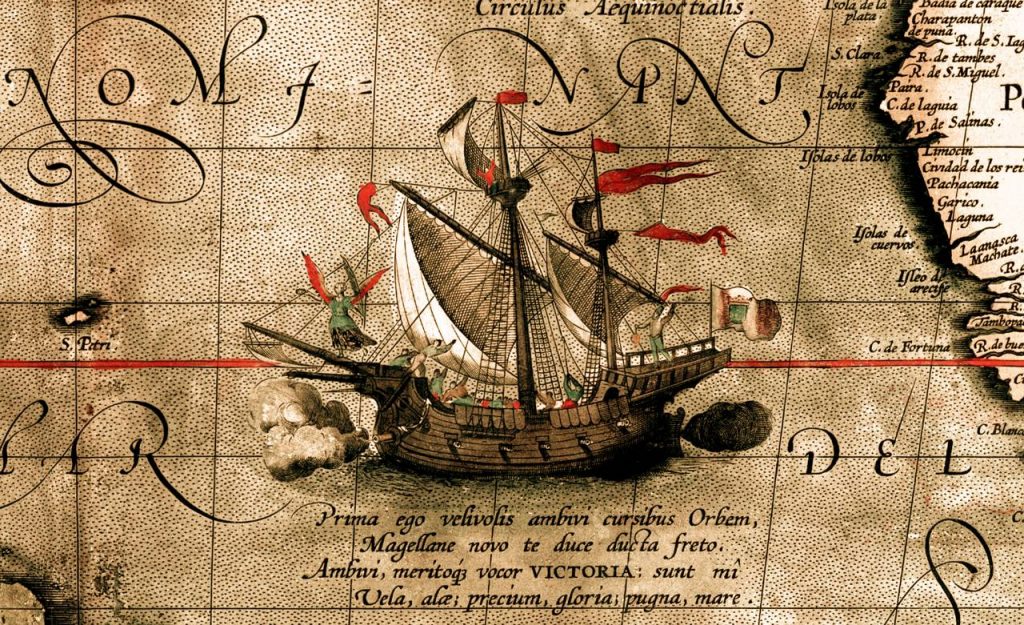
Victoria, the single ship to have completed the first world circumnavigation. (Detail from Maris Pacifici by Ortelius, 1589.) / Wikimedia Commons
A time when Europe was swept up in the Renaissance and the Reformation, other major changes were taking place in the world.
Introduction
With today’s global positioning satellites, Internet maps, cell phones, and superfast travel, it is hard to imagine exactly how it might have felt to embark on a voyage across an unknown ocean. What lay across the ocean? In the early 1400s in Europe, few people knew. How long would it take to get there? That depended on the wind, the weather, and the distance. Days would have run together, with no sounds but the voices of the captain and the crew, the creaking of the sails, the blowing wind, and the splash of waves against the ship’s hull.
Would you be willing to undertake such a voyage? Only those most adventurous, most daring, and most confident in their abilities to sail in any weather, manage any crew, and meet any circumstance dared do so. They sailed west from England, Spain, and Portugal to North America. They sailed south from Portugal and Spain to South America, to lands where the Incas lived. They traveled to Africa, past the kingdoms of Ghana, Mali, and Songhai. The crew of one Portuguese expedition even sailed completely around the world.
European explorers changed the world in many dramatic ways. Because of them, cultures divided by 3,000 miles or more of water began interacting. European countries claimed large parts of the world. As nations competed for territory, Europe had an enormous impact on people living in distant lands.
The Americas, in turn, made important contributions to Europe and the rest of the world. For example, from the Americas came crops such as corn and potatoes, which grew well in Europe. By increasing Europe’s food supply, these crops helped create population growth.
Another great change during the early modern age was the Scientific Revolution. Between 1500 and 1700, scientists used observation and experiments to make dramatic discoveries. For example, Isaac Newton formulated the laws of gravity. The Scientific Revolution also led to the invention of new tools, such as the microscope and the thermometer.
Advances in science helped pave the way for a period called the Enlightenment. The Enlightenment began in the late 1600s. Enlightenment thinkers used observation and reason to try to solve problems in society. Their work led to new ideas about government, human nature, and human rights.
The Age of Exploration, the Scientific Revolution, and the Enlightenment helped to shape the world we live in today.
The Causes of European Exploration
Overview
Why did European exploration begin to flourish in the 1400s? Two main reasons stand out. First, Europeans of this time had several motives for exploring the world. Second, advances in knowledge and technology helped to make the Age of Exploration possible.
Motives for Exploration

Asian spices / Creative Commons
For early explorers, one of the main motives for exploration was the desire to find new trade routes to Asia. By the 1400s, merchants and Crusaders had brought many goods to Europe from Africa, the Middle East, and Asia. Demand for these goods increased the desire for trade.
Europeans were especially interested in spices from Asia. They had learned to use spices to help preserve food during winter and to cover up the taste of food that was no longer fresh.
Trade with the East, however, was difficult and very expensive. Muslims and Italians controlled the flow of goods. Muslim traders carried goods to the east coast of the Mediterranean Sea. Italian merchants then brought the goods into Europe. Problems arose when Muslim rulers sometimes closed the trade routes from Asia to Europe. Also, the goods went through many hands, and each trading party raised the price.
European monarchs and merchants wanted to break the hold that Muslims and Italians had on trade. One way to do so was to find a sea route to Asia. Portuguese sailors looked for a route that went around Africa. Christopher Columbus tried to reach Asia by sailing west across the Atlantic.
Other motives also came into play. Many people were excited by the opportunity for new knowledge. Explorers saw the chance to earn fame and glory, as well as wealth. As new lands were discovered, nations wanted to claim the lands’ riches for themselves.
A final motive for exploration was the desire to spread Christianity beyond Europe. Both Protestant and Catholic nations were eager to make new converts. Missionaries of both faiths followed the paths blazed by explorers.
Advances in Knowledge and Technology

The Fra Mauro map, a medieval European map, was made around 1450 by the Italian monk Fra Mauro. It is a circular world map drawn on parchment and set in a wooden frame, about two meters in diameter. / Wikimedia Commons
The Age of Exploration began during the Renaissance. The Renaissance was a time of new learning. A number of advances during that time made it easier for explorers to venture into the unknown.
One key advance was in cartography, the art and science of mapmaking. In the early 1400s, an Italian scholar translated an ancient book called Guide to Geography from Greek into Latin. The book was written by the thinker Ptolemy (TOL-eh-mee) in the 2nd century C.E. Printed copies of the book inspired new interest in cartography. European mapmakers used Ptolemy’s work as a basis for drawing more accurate maps.
Discoveries by explorers gave mapmakers new information with which to work. The result was a dramatic change in Europeans’ view of the world. By the 1500s, Europeans made globes, showing Earth as a sphere. In 1507, a German cartographer made the first map that clearly showed North and South America as separate from Asia.
In turn, better maps made navigation easier. The most important Renaissance geographer, Gerardus Mercator (mer-KAY-tur), created maps using improved lines of longitude and latitude. Mercator’s mapmaking technique was a great help to navigators.
An improved ship design also helped explorers. By the 1400s, Portuguese and Spanish shipbuilders were making a new type of ship called a caravel. These ships were small, fast, and easy to maneuver. Their special bottoms made it easier for explorers to travel along coastlines where the water was not deep. Caravels also used lateen sails, a triangular style adapted from Muslim ships. These sails could be positioned to take advantage of the wind no matter which way it blew.
Along with better ships, new navigational tools helped sailors travel more safely on the open seas. By the end of the 1400s, the compass was much improved. Sailors used compasses to find their bearing, or direction of travel. The astrolabe helped sailors determine their distance north or south from the equator.
Finally, improved weapons gave Europeans a huge advantage over the people they met in their explorations. Sailors could fire their cannons at targets near the shore without leaving their ships. On land, the weapons of native peoples often were no match for European guns, armor, and horses.
Portugal Begins the Age of Exploration
The Age of Exploration began in Portugal. This small country is located on the Iberian Peninsula. Its rulers sent explorers first to nearby Africa and then around the world.
Key Portuguese Explorers
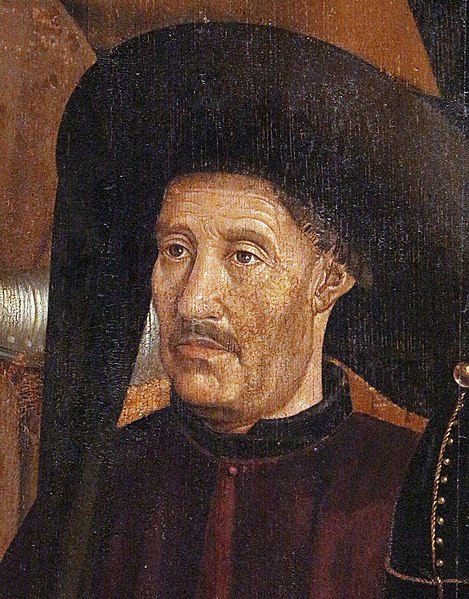
Prince Henry the Navigator / National Museum of Ancient Art, Wikimedia Commons
The major figure in early Portuguese exploration was Prince Henry, the son of King John I of Portugal. Nicknamed “the Navigator,” Prince Henry was not an explorer himself. Instead, he encouraged exploration and planned and directed many important expeditions.
Beginning in about 1418, Henry sent explorers to sea almost every year. He also started a school of navigation where sailors and mapmakers could learn their trades. His cartographers made new maps based on the information ship captains brought back.
Henry’s early expeditions focused on the west coast of Africa. He wanted to continue the Crusades against the Muslims, find gold, and take part in Asian trade.
Gradually, Portuguese explorers made their way farther and farther south. In 1488, Bartolomeu Dias became the first European to sail around the southern tip of Africa.
In July 1497, Vasco da Gama set sail with four ships to chart a sea route to India. Da Gama’s ships rounded Africa’s southern tip and then sailed up the east coast of the continent. With the help of a sailor who knew the route to India from there, they were able to across the Indian Ocean.
Da Gama arrived in the port of Calicut, India, in May 1498. There he obtained a load of cinnamon and pepper. On the return trip to Portugal, da Gama lost half of his ships. Still, the valuable cargo he brought back paid for the voyage many times over. His trip made the Portuguese even more eager to trade directly with Indian merchants.
In 1500, Pedro Cabral (kah-BRAHL) set sail for India with a fleet of 13 ships. Cabral first sailed southwest to avoid areas where there are no winds to fill sails. But he sailed so far west that he reached the east coast of present-day Brazil. After claiming this land for Portugal, he sailed back to the east and rounded Africa. Arriving in Calicut, he established a trading post and signed trade treaties. He returned to Portugal in June 1501.
The Impact of Portuguese Exploration
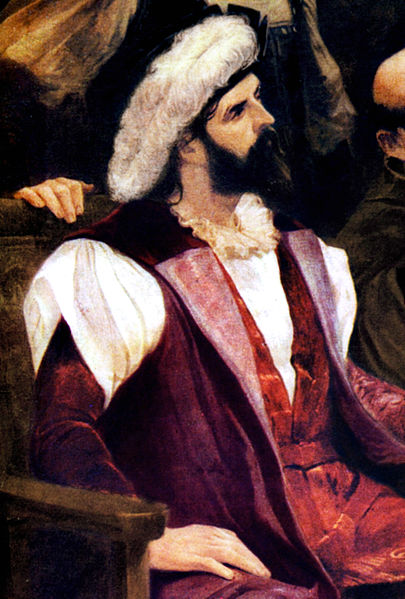
A 32- to 33-year old Pedro Álvares Cabral in an early 20th-century painting. / Wikimedia Commons
Portugal’s explorers changed Europeans’ understanding of the world in several ways. They explored the coasts of Africa and brought back gold and enslaved Africans. They also found a sea route to India. From India, explorers brought back spices, such as cinnamon and pepper, and other goods, such as porcelain, incense, jewels, and silk.
After Cabral’s voyage, the Portuguese took control of the eastern sea routes to Asia. They seized the seaport of Goa (GOH-uh) in India and built forts there. They attacked towns on the east coast of Africa. They also set their sights on the Moluccas, or Spice Islands, in what is now Indonesia. In 1511, they attacked the main port of the islands and killed the Muslim defenders. The captain of this expedition explained what was at stake. If Portugal could take the spice trade away from Muslim traders, he wrote, then Cairo and Makkah “will be ruined.” As for Italian merchants, “Venice will receive no spices unless her merchants go to buy them in Portugal.”
Portugal’s control of the Indian Ocean broke the hold Muslims and Italians had on Asian trade. With the increased competition, prices of Asian goods—such as spices and fabrics—dropped, and more people in Europe could afford to buy them.
During the 1500s, Portugal also began to establish colonies in Brazil. The native people of Brazil suffered greatly as a result. The Portuguese forced them to work on sugar plantations, or large farms. They also tried to get them to give up their religion and convert to Christianity. Missionaries sometimes tried to protect them from abuse, but countless numbers of native peoples died from overwork and from European diseases. Others fled into the interior of Brazil.
The colonization of Brazil also had a negative impact on Africa. As the native population of Brazil decreased, the Portuguese needed more laborers. Starting in the mid–1500s, they turned to Africa. Over the next 300 years, ships brought millions of enslaved West Africans to Brazil.
Later Spanish Exploration and Conquest
Overview
After Columbus’s voyages, Spain was eager to claim even more lands in the New World. To explore and conquer “New Spain,” the Spanish turned to adventurers called conquistadors, or conquerors. The conquistadors were allowed to establish settlements and seize the wealth of natives. In return, the Spanish government claimed some of the treasures they found.
Key Explorers

18th century portrait of Hernán Cortés / Real Academia de Bellas Artes de San Fernando, Wikimedia Commons
In 1519, Spanish explorer Hernán Cortés (er–NAHN koor–TEZ), with and a band of fellow conquistadors, set out to explore present-day Mexico. Native people in Mexico told Cortés about the Aztecs. The Aztecs had built a large and wealthy empire in Mexico.
With the help of a native woman named Malinche (mah–LIN–chay), Cortés and his men reached the Aztec capital, Tenochtitlán (tay–nawh–tee–TLAHN). The Aztec ruler, Moctezuma II, welcomed the Spanish with great honors. Determined to break the power of the Aztecs, Cortés took Moctezuma hostage.
Cortés now controlled the Aztec capital. In 1520, he left the city of Tenochtitlán to battle a rival Spanish force. While he was away, a group of conquistadors attacked the Aztecs in the middle of a religious celebration. In response, the Aztecs rose up against the Spanish. The soldiers had to fight their way out of the city. Many of them were killed during the escape.
The following year, Cortés mounted a siege of the city, aided by thousands of native allies who resented Aztec rule. The Aztecs ran out of food and water, yet they fought desperately. After several months, the Spanish captured the Aztec leader, and Aztec resistance collapsed. The city was in ruins. The mighty Aztec Empire was no more.
Four factors contributed to the defeat of the Aztec Empire. First, Aztec legend had predicted the arrival of a white-skinned god. When Cortés appeared, the Aztecs welcomed him because they thought he might be this god, Quetzalcoatl. Second, Cortés was able to make allies of the Aztecs’ enemies. Third, their horses, armor, and superior weapons gave the Spanish an advantage in battle. Fourth, the Spanish carried diseases that caused deadly epidemics among the Aztecs.
Aztec riches inspired Spanish conquistadors to continue their search for gold. In the 1520s, Francisco Pizarro received permission from Spain to conquer the Inca Empire in South America. The Incas ruled an empire that extended throughout most of the Andes Mountains. By the time Pizarro arrived, however, a civil war had weakened that empire.
In April 1532, the Incan emperor, Atahualpa (ah–tuh–WAHL–puh), greeted the Spanish as guests. Following Cortés’s example, Pizarro launched a surprise attack and kidnapped the emperor. Although the Incas paid a roomful of gold and silver in ransom, the Spanish killed Atahualpa. Without their leader, the Inca Empire quickly fell apart.
The Impact of Later Spanish Exploration and Conquest
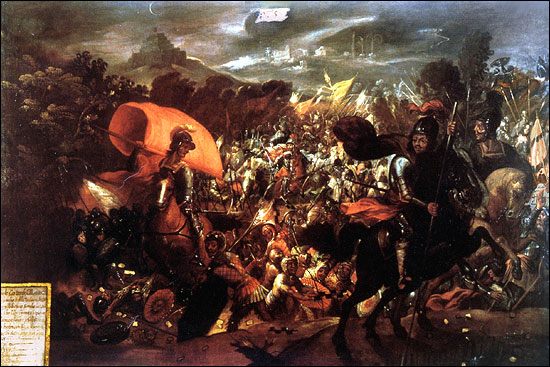
La Noche Triste – The Sad Night, the fall of Aztec Tenochtitlan / Wikimedia Commons
The explorations and conquests of the conquistadors transformed Spain. The Spanish rapidly expanded foreign trade and overseas colonization. For a time, wealth from the Americas made Spain one of the world’s richest and most powerful countries.
Besides gold and silver, ships from the Americas brought corn and potatoes to Spain. These crops grew well in Europe. The increased food supply helped spur a population boom. Conquistadors also introduced Europeans to new luxury items, such as chocolate.
In the long run, however, gold and silver from the Americas hurt Spain’s economy. Inflation, or an increase in the supply of money, led to a loss of its value. It now cost people a great deal more to buy goods with the devalued money. Additionally, monarchs and the wealthy spent their riches on luxuries, instead of building Spain’s industries.
The Spanish conquests had a major impact on the New World. The Spanish introduced new animals to the Americas, such as horses, cattle, sheep, and pigs. But they destroyed two advanced civilizations. The Aztecs and Incas lost much of their culture along with their wealth. Many became laborers for the Spanish. Millions died from disease. In Mexico, for example, there were about twenty-five million native people in 1519. By 1605, this number had dwindled to one million.
Other European Explorations
Overview
Spain and Portugal dominated the early years of exploration. But rulers in rival nations wanted their own share of trade and new lands in the Americas. Soon England, France, and the Netherlands all sent expeditions to North America.
Key Explorers
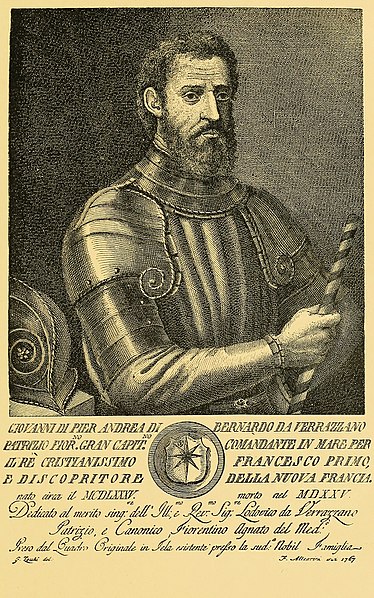
Giovanni da Verrazano / Wikimedia Commons
Explorers often sailed for any country that would pay for their voyages. The Italian sailor John Cabot made England’s first voyage of discovery. Cabot believed he could reach the Indies by sailing northwest across the Atlantic. In 1497, he landed in what is now Canada. Believing he had reached the northeast coast of Asia, he claimed the region for England.
Another Italian, Giovanni da Verrazano, sailed under the French flag. In 1524, Verrazano explored the Atlantic coast from present-day North Carolina to Canada. His voyage gave France its first claims in the Americas. Unfortunately, on a later trip to the West Indies, he was killed by native people.
Sailing on behalf of the Netherlands, English explorer Henry Hudson journeyed to North America in 1609. Hudson wanted to find a northwest passage through North America to the Pacific Ocean. Such a water route would allow ships to sail from Europe to Asia without entering waters controlled by Spain.
Hudson did not find a northwest passage, but he did explore what is now called the Hudson River in present-day New York State. His explorations were the basis of the Dutch claim to the area. Dutch settlers established the colony of New Amsterdam on Manhattan in 1625.
In 1610, Hudson tried again, this time under the flag of his native England. Searching farther north, he sailed into a large bay in Canada that is now called Hudson Bay. He spent three months looking for an outlet to the Pacific, but there was none.
After a hard winter in the icy bay, some of Hudson’s crew rebelled. They set him, his son, and seven loyal followers adrift in a small boat. Hudson and the other castaways were never seen again. Hudson’s voyage, however, laid the basis for later English claims in Canada.
The Impact of European Exploration of North America
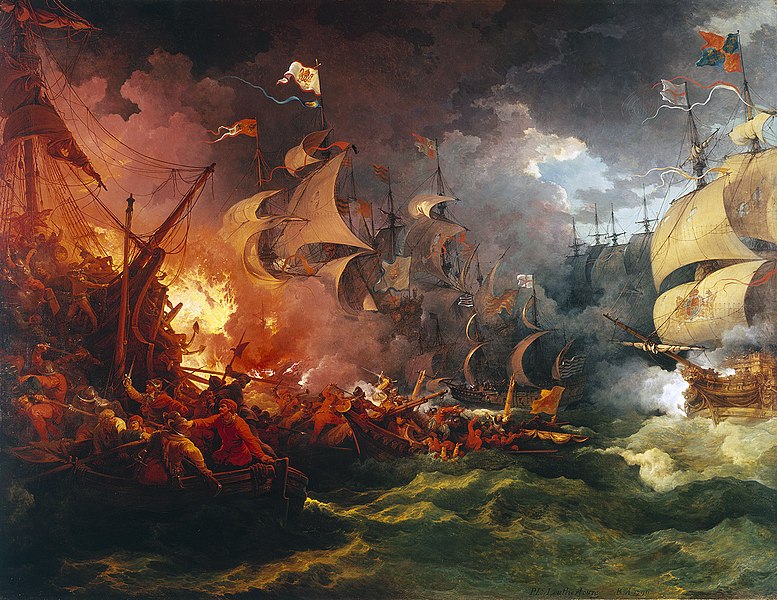
Defeat of the Spanish Armada, 8 August 1588, Philip James de Loutherbourg / National Maritime Museum, Greenwich Hospital Collection, Wikimedia Commons
Unlike the conquistadors in the south, northern explorers did not find gold and other treasure. As a result, there was less interest, at first, in starting colonies in that region.
Canada’s shores did offer rich resources of cod and other fish. Within a few years of Cabot’s trip, fishing boats regularly visited the region. Europeans were also interested in trading with Native Americans for whale oil and otter, beaver, and fox furs. By the early 1600s, Europeans had set up a number of trading posts in North America.
English exploration also contributed to a war between England and Spain. As English ships roamed the seas, some captains, nicknamed “sea dogs,” began raiding Spanish ports and ships to take their gold. Between 1577 and 1580, sea dog Francis Drake sailed around the world. He also claimed part of what is now California for England, ignoring Spain’s claims to the area.
The English raids added to other tensions between England and Spain. In 1588, King Philip II of Spain sent an armada, or fleet of ships, to invade England. With 130 heavily armed vessels and about thirty thousand men, the Spanish Armada seemed an unbeatable force. But the smaller English fleet was fast and well armed. Their guns had a longer range, so they could attack from a safe distance. After several battles, a number of the armada’s ships had been sunk or driven ashore. The rest turned around but faced terrible storms on the way home. Fewer than half of the ships made it back to Spain.
The defeat of the Spanish Armada marked the start of a shift in power in Europe. By 1630, Spain no longer dominated the continent. With Spain’s decline, other countries—particularly England and the Netherlands—took a more active role in trade and colonization around the world.
Bartolomé de Las Casas: From Conquistador to Protector of the Indians
Overview

Bartolomé de las Casas / General Archive of the Indies, Wikimedia Commons
Bartolomé de las Casas experienced a remarkable change of heart during his lifetime. At first, he participated in Spain’s conquest and settlement of the Americas. Later in life, he criticized and condemned it. For more than fifty years, he fought for the rights of the defeated and enslaved peoples of Latin America. How did this conquistador become known as “the Protector of the Indians?”
Bartolomé de las Casas (bahr–taw–law–MEY day las KAH-sahs) ran through the streets of Seville, Spain, on March 31, 1493. He was just nine years old and on his way to see Christopher Columbus, who had just returned from his first voyage to the Americas. Bartolomé wanted to see him and the “Indians,” as they were called, as they paraded to the church.
Bartolomé’s father and uncles were looking forward to seeing Columbus, as well. Like many other people in Europe during the late 1400s, they saw the Americas as a place of opportunity. They signed up to join Columbus on his second voyage. Two years after that, Bartolomé followed in his father’s footsteps and voyaged to the Americas himself. He sailed to the island of Hispaniola, the present-day nations of Haiti and the Dominican Republic.
Las Casas as Conquistador and Priest
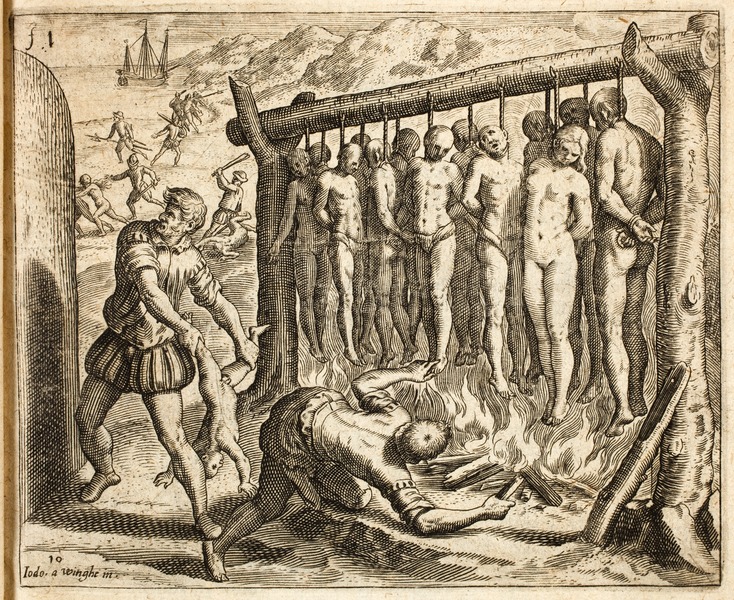
Depiction of Spanish atrocities committed in the conquest of Cuba in Las Casas’s “Brevisima relación de la destrucción de las Indias”. The print was made by two Flemish artists who had fled the Southern Netherlands because of their Protestant faith: Joos van Winghe was the designer and Theodor de Bry the engraver. / Peace Palace Library, Wikimedia Commons
One historian wrote that when Las Casas first arrived in the Americas, he was “not much better than the rest of the gentlemen-adventurers who rushed to the New World, bent on speedily acquiring fortunes.” He supported the Spanish conquest of the Americas and was a loyal servant of Spain’s king and queen, Ferdinand and Isabella. Once in Hispaniola, Las Casas helped to manage his father’s farms and businesses. Enslaved Indians worked in the family’s fields and mines.
Spanish conquistadors wanted to gain wealth and glory in the Americas. They had another goal, as well—to convert Indians to Christianity. Las Casas shared this goal. So, the young conquistador went back to Europe to become a priest. He returned to Hispaniola sometime in 1509 or 1510. There he began to teach and baptize the Indians. At the same time, he continued to manage Indian slaves.
On a Path to Change
History often seems to be made up of moments when someone has a change of heart. The path that he or she has been traveling takes a dramatic turn. It often appears to others that this change is sudden. In reality, a series of events usually causes a person to make the decision to change. One such event happened to Las Casas in 1511.
Roman Catholics in Hispaniola witnessed horrible acts of cruelty and injustice against the native peoples of the West Indies at the hands of the Spanish conquistadors. One of the priests there, Father Antonio de Montesinos, spoke out against the harsh treatment of the Indians in a sermon delivered to a Spanish congregation in Hispaniola in 1511. De Montesinos said:
You are in mortal sin . . . for the cruelty and tyranny you use in
dealing with these innocent people . . . by what right or justice do
you keep these Indians in such a cruel and horrible servitude?
. . . Why do you keep them so oppressed? . . . Are not these people
also human beings?
One historian called this sermon “the first cry for justice in America” on behalf of the Indians. Las Casas recorded the sermon in one of his books, History of the Indies. No one is sure if he was present at the sermon or heard about it later. But one thing seems certain; even though he must have seen some of the same injustices described by de Montesinos, Las Casas continued to support the Spanish conquest and the goals of conquering new lands, earning wealth, and converting Indians to Christianity.
However, in 1513, something happened that changed Las Casas’s life. He took part in the conquest of Cuba. As a reward, he received more Indian slaves and an encomienda, or land grant. But he also witnessed a massacre. The Spanish killed thousands of innocent Indians, including women and children, who had welcomed the Spanish into their town. In his book The Devastation of the Indies: A Brief Account, he wrote, “I saw here cruelty on a scale no living being has ever seen or expects to see.”
A Turning Point
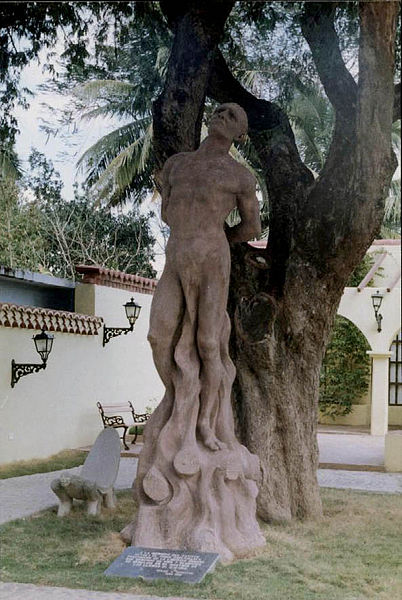
Monument of Taino chief Hatuey in Yara city, depicting the moment he was burnt by Spanish soldiers / Photo by Astroheredero, Wikimedia Commons
The Cuban massacre in 1513 and other scenes of violence against Indians Las Casas witnessed finally pushed him to a turning point. He could no longer believe that the Spanish conquest was right. Before, he had thought that only some individuals acted cruelly and inhumanely. Now he saw that the whole Spanish system of conquest brought only death and suffering to the people of the West Indies.
On August 15, 1514, when he was about thirty years old, Las Casas gave a startling sermon. He asked his congregation to free their enslaved Indians. He also said that they had to return or pay for everything they had taken away from the Indians. He refused to forgive the colonists’ sins in confession if they used Indians as forced labor. Then he announced that he would give up his ownership of Indians and the business he had inherited from his father.
Protector of the Indians
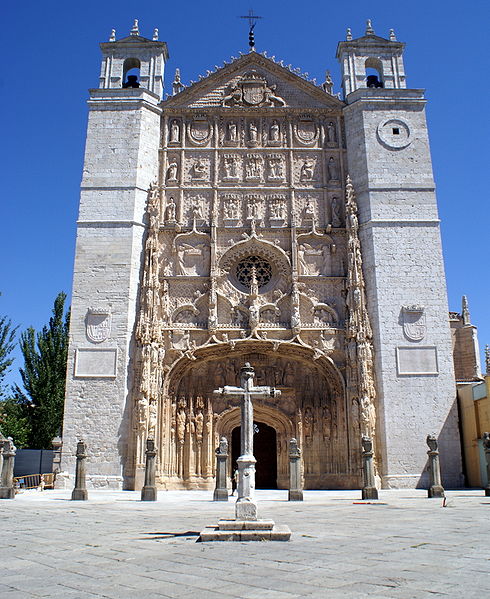
The Church of the Dominican Convent of San Pablo in Valladolid where Bartolomé de Las Casas was consecrated as Bishop on March 30, 1544. / Photo by Rastrojo, Wikimedia Commons
For the rest of his life, Las Casas fought for the rights of the Indians in the Americas. He traveled back and forth to Europe working on their behalf. He talked with popes and kings, debated enemies, and wrote letters and books on the subject.
Las Casas influenced both a pope and a king. In 1537, Pope Paul III wrote that Indians were free human beings, not slaves, and that anyone who enslaved them could be thrown out of the Catholic Church. In 1542, Holy Roman emperor Charles V, who ruled Spain, issued the New Laws, banning slavery in Spanish America.
In 1550 and 1551, Las Casas also took part in a famous debate against Juan Ginés Sepúlveda in Spain. Sepúlveda tried to prove that Indians were “natural slaves.” Many Spanish, especially those hungry for wealth and glory, shared this belief. Las Casas passionately argued against Sepúlveda with the same message he would deliver over and over throughout his life. Las Casas argued that:
• Indians, like all human beings, have rights to life and liberty.
• The Spanish stole Indian land through bloody and unjust wars.
• There is no such thing as a good encomienda.
• Indians have the right to make war against the Spanish.
Las Casas died in 1566. The voices and the deeds of the conquistadors slowly eroded the memory of his words. But in other European countries, people began to read The Devastation of the Indies: A Brief Account. As time passed, more of Las Casas’s works were published. In the centuries to follow, fighters for justice took up his name as a symbol for their own struggles for human rights.
The Legacy of Las Casas
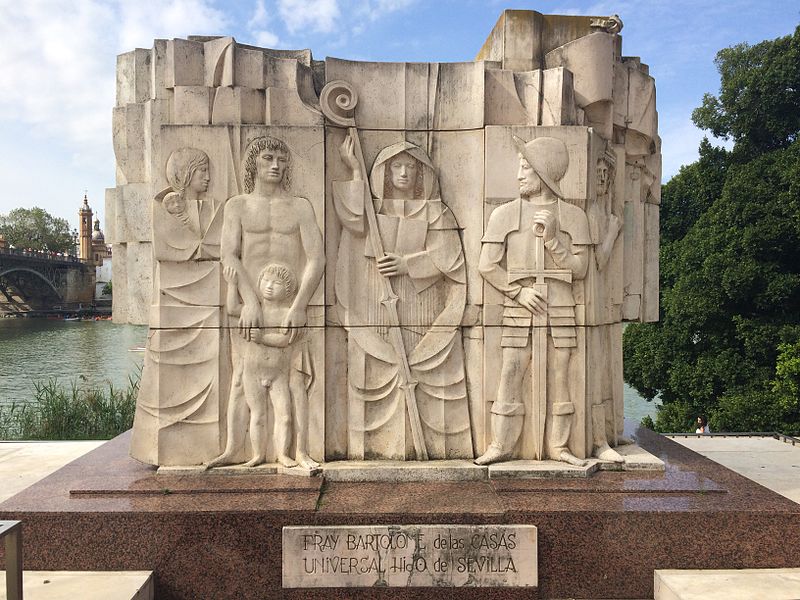
Monument to Bartolomé de las Casas in Seville, Spain / Photo by Hispalois, Wikimedia Commons
Today, historians remember Las Casas as the first person to actively oppose the oppression of Indians and to call for an end to Indian slavery. Later, in the 19th century, Las Casas inspired both Father Hidalgo, the father of Mexican independence, and Simón Bolívar, the liberator of South America.
In the 1960s, Mexican American César Chávez learned about injustice at an early age. His family worked as migrants, moving from place to place to pick crops. With barely an eighth-grade education, Chávez organized workers, formed a union, and won better pay and better working and living conditions. Speaking for the powerless, he rallied people to his side with his cry, “Sí, Se Puede!” (“Yes, We Can!”) Just as the name “Chávez” will always be connected to the struggles of the farm workers, the name “Las Casas” will forever be connected to any fight for human rights and dignity for the native people of the Americas.
The Impact of Exploration on Europe
The voyages of explorers had a dramatic impact on European commerce and economies. As a result of exploration, more goods, raw materials, and precious metals entered Europe. Mapmakers carefully charted trade routes and the locations of newly discovered lands. By the 1700s, European ships traveled trade routes that spanned the globe. New centers of commerce developed in the port cities of the Netherlands and England.
Exploration and trade contributed to the growth of capitalism. This economic system is based on investing money for profit. Merchants gained great wealth by trading and selling goods from around the world. Many of them used their profits to finance still more voyages and to start trading companies. Other people began investing money in these companies and shared in the profits. Soon, this type of shared ownership was applied to other kinds of businesses.
Another aspect of the capitalist economy concerned the way people exchanged goods and services. Money became more important as precious metals flowed into Europe. Instead of having a fixed price, items were sold for prices that were set by the open market. This meant that the price of an item depended on how much of the item was available and how many people wanted to buy it. Sellers could charge high prices for scarce items that many people wanted. If the supply of an item was large and few people wanted it, sellers lowered the price. This kind of system, based on supply and demand, is called a market economy.
Labor, too, was given a money value. Increasingly, people began working for hire instead of directly providing for their own needs. Merchants hired people to work from their own cottages, turning raw materials from overseas into finished products. This growing cottage industry was especially important in the manufacture of textiles. Often, entire families worked at home, spinning wool into thread or weaving thread into cloth. Cottage industry was a step toward the system of factories operated by capitalists in later centuries.
A final result of exploration was a new economic policy called mercantilism. European rulers believed that building up wealth was the best way to increase a nation’s power. For this reason, they tried to reduce the products they bought from other countries and to increase the items they sold.
Having colonies was a key part of this policy. Nations looked to their colonies to supply raw materials for their industries at home. These industries turned the raw materials into finished goods that they could sell back to their colonies, as well as to other countries. To protect this valuable trade with their colonies, rulers often forbade colonists from trading with other nations.
Originally published by Flores World History, free and open access, republished for educational, non-commercial purposes.
A Timeline of India in the 1800s
:max_bytes(150000):strip_icc()/McNamara-headshot-history1800s-5b7422c046e0fb00504dcf97.jpg)
Robert J. McNamara is a history expert and former magazine journalist. He was Amazon.com’s first-ever history editor and has bylines in New York, the Chicago Tribune, and other national outlets.
The British East India Company arrived in India in the early 1600s, struggling and nearly begging for the right to trade and do business. Within 150 years the thriving firm of British merchants, backed by its own powerful private army, was essentially ruling India.
In the 1800s English power expanded in India, as it would until the mutinies of 1857-58. After those very violent spasms things would change, yet Britain was still in control. And India was very much an outpost of the mighty British Empire.
1600s: The British East India Company Arrived
After several attempts to open trade with a powerful ruler of India failed in the earliest years of the 1600s, King James I of England sent a personal envoy, Sir Thomas Roe, to the court of the Mogul emperor Jahangir in 1614.
The emperor was incredibly wealthy and lived in an opulent palace. And he was not interested in trade with Britain as he couldn’t imagine the British had anything he wanted.
Roe, recognizing that other approaches had been too subservient, was deliberately difficult to deal with at first. He correctly sensed that earlier envoys, by being too accommodating, had not gained the emperor’s respect. Roe’s stratagem worked, and the East India Company was able to establish operations in India.
1600s: The Mogul Empire at Its Peak
![]()
The Mogul Empire had been established in India in the early 1500s, when a chieftain named Babur invaded India from Afghanistan. The Moguls (or Mughals) conquered most of northern India, and by the time the British arrived the Mogul Empire was immensely powerful.
One of the most influential Mogul emperors was Jahangir’s son Shah Jahan, who ruled from 1628 to 1658. He expanded the empire and accumulated enormous treasure, and made Islam the official religion. When his wife died he had the Taj Mahal built as a tomb for her.
The Moguls took great pride in being patrons of the arts, and painting, literature, and architecture flourished under their rule.
1700s: Britain Established Dominance
The Mogul Empire was in a state of collapse by the 1720s. Other European powers were competing for control in India, and sought alliances with the shaky states that inherited the Mogul territories.
The East India Company established its own army in India, which was composed of British troops as well as native soldiers called sepoys.
The British interests in India, under the leadership of Robert Clive, gained military victories from the 1740s onward, and with the Battle of Plassey in 1757 were able to establish dominance.
The East India Company gradually strengthened its hold, even instituting a court system. British citizens began building an “Anglo-Indian” society within India, and English customs were adapted to the climate of India.
1800s: “The Raj” Entered the Language
![]()
The British rule in India became known as “The Raj,” which was derived from the Sanskrit term raja meaning king. The term did not have official meaning until after 1858, but it was in popular usage many years before that.
Incidentally, a number of other terms came into English usage during The Raj: bangle, dungaree, khaki, pundit, seersucker, jodhpurs, cushy, pajamas, and many more.
British merchants could make a fortune in India and would then return home, often to be derided by those in British high society as nabobs, the title for an official under the Moguls.
Tales of life in India fascinated the British public, and exotic Indian scenes, such as a drawing of an elephant fight, appeared in books published in London in the 1820s.
1857: Resentment Toward the British Spilled Over
![]()
The Indian Rebellion of 1857, which was also called the Indian Mutiny, or the Sepoy Mutiny, was a turning point in the history of Britain in India.
The traditional story is that Indian troops, called sepoys, mutinied against their British commanders because newly issued rifle cartridges were greased with pig and cow fat, thus making them unacceptable for both Hindu and Muslim soldiers. There is some truth to that, but there were a number of other underlying causes for the rebellion.
Resentment toward the British had been building for some time, and new policies which allowed the British to annex some areas of India exacerbated tensions. By early 1857 things had reached a breaking point.
1857-58: The Indian Mutiny
The Indian Mutiny erupted in May 1857, when sepoys rose up against the British in Meerut and then massacred all the British they could find in Delhi.
Uprisings spread throughout British India. It was estimated that less than 8,000 of nearly 140,000 sepoys remained loyal to the British. The conflicts of 1857 and 1858 were brutal and bloody, and lurid reports of massacres and atrocities circulated in newspapers and illustrated magazines in Britain.
The British dispatched more troops to India and eventually succeeded in putting down the mutiny, resorting to merciless tactics to restore order. The large city of Delhi was left in ruins. And many sepoys who had surrendered were executed by British troops.
1858: Calm Was Restored
![]()
Following the Indian Mutiny, the East India Company was abolished and the British crown assumed full rule of India.
Reforms were instituted, which included tolerance of religion and the recruitment of Indians into the civil service. While the reforms sought to avoid further rebellions through conciliation, the British military in India was also strengthened.
Historians have noted that the British government never actually intended to take control of India, but when British interests were threatened the government had to step in.
The embodiment of the new British rule in India was the office of the Viceroy.
1876: Empress of India
The importance of India, and the affection the British crown felt for its colony, was emphasized in 1876 when Prime Minister Benjamin Disraeli declared Queen Victoria to be “Empress of India.”
British control of India would continue, mostly peacefully, throughout the remainder of the 19th century. It wasn’t until Lord Curzon became Viceroy in 1898, and instituted some very unpopular policies, that an Indian nationalist movement began to stir.
The nationalist movement developed over decades, and, of course, India finally achieved independence in 1947.
Source https://www.thoughtco.com/indian-ocean-trade-routes-195514
Source https://brewminate.com/causes-and-impacts-of-the-european-age-of-exploration/
Source https://www.thoughtco.com/timeline-of-india-in-the-1800s-1774016